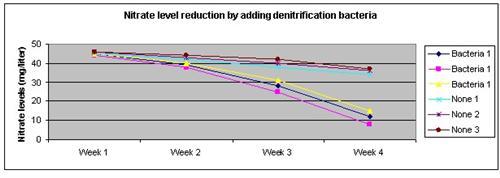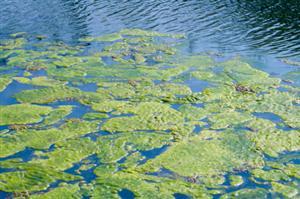| Complexity level: | 8 |
| Project cost ($): | 30 |
| Time required: | 1 day for preparation, 21 days for observation |
| Material availability: | Easily found |
| Safety concerns: | None |
Hypothesis
Nitrate-rich water containing denitrifying bacteria will exhibit a faster rate of reduction in nitrate levels.
Overview
Nitrate contamination
The use of fertilizers to improve soil fertility and enhance plant growth has resulted in the contamination of nitrogen compounds such as ammonia, nitrate and nitride in our rivers, lakes and ocean. During soil erosion or heavy rain, flowing water will wash nitrates into the nearest lakes and rivers. This causes the pollution and contamination of the water.
The presence of nitrates in rivers and lakes encourages the growth of algae in the water. The growth of algae will reduce the levels of dissolved oxygen in the water and this poses a problem for the survival of the fish and other living organisms in the water.
Denitrifying bacteria helps to metabolize nitrogen compounds using enzymes to release nitrogen gas. This is an anaerobic process and will only take place in an environment where there is very little oxygen. It is a common occurrence in deep soil and stagnant water. This process is part of the nitrogen cycle, releasing nitrogen gas back into the atmosphere.
Scientific Terms
Materials
The materials required for the experiment:
- 2000 milliliters of water from an algae-rich pond
- 1 plastic container with 2 liter capacity
- 15ml of Nitrobacter
- 15ml of Nitrosomonas bacteria
- 6 beakers
- 1 measuring cylinder
- 1 syringe
- 1 roll of plastic wrap
- 1 nitrate test kit
Procedure
1. For this experiment, the independent variable is the introduction of denitrifying bacteria. The dependent variable is the concentration of nitrate in the water. This is determined by testing the water using the nitrate test kit. The constants (control variables) are the size of the water sample, the amount of the denitrifying bacteria present in each water sample and the temperature of the environment, which will remain at room temperature.
2. Label each of the beakers Bacteria 1, Bacteria 2, Bacteria 3, None 1, None 2 and None 3. Measure and pour about 300ml of pond water into each of the 6 beakers.
3. Using the nitrate test kit, measure the level of nitrate in the water samples in each beaker. Record the measurments in a table, as shown below.
4. Using a syringe, add 5ml of the Nitrobacter bacteria and another 5ml of Nitrosomonas bacteria is to each of the 3 beakers labeled as Bacteria 1, Bacteria 2 and Bacteria 3.
5. Cover all 6 beakers using the plastic wrap. Once a week for the next 3 weeks, open the plastic cover to obtain a water sample and measure the nitrate levels in each beaker. Record the measurements in a table, as shown below.

Results
It is observed that the beakers with the denitrifying bacteria added have a faster rate of reduction in the nitrate levels.
| Beaker marking | Nitrate content in the water sample with and without adding bacteria ( mg/liter) | |||
| Start | Week 1 | Week 2 | Week 3 | |
| Bacteria 1 | 45 | 39 | 28 | 12 |
| Bacteria 1 | 44 | 38 | 25 | 8 |
| Bacteria 1 | 45 | 40 | 31 | 15 |
| None 1 | 45 | 42 | 38 | 34 |
| None 2 | 46 | 43 | 40 | 36 |
| None 3 | 46 | 44 | 42 | 37 |
The chart below represents the results of our science fair project

Conclusion
The hypothesis that nitrate-rich water containing denitrifying bacteria will have a faster rate of reduction in nitrate levels has been proven to be true.
The level of nitrate and nitrite in the drinking water is normally regulated for the safety and protection of human health and also for the preservation of the aquatic ecosystem. US drinking water standards require the levels of nitrate to be kept below 10mg/liter and nitrite to be kept below 1.0ml/liter. High levels of nitrate in drinking water are known to affect the ability of blood to carry oxygen and cause the blue baby syndrome in infants.
Also consider
The experiment may be repeated to check the levels of ammonia and nitrite in water.
The experiment may also be modified to compare the effect of denitrification in water samples from different sources.
References
Denitrifying bacteria - http://en.wikipedia.org/wiki/Denitrifying_bacteria
Water quality - http://www.undeerc.org/watman/fmriver/PPTV/nitrite.asp
Selecting forms of nitrogen fertilizer - http://ohioline.osu.edu/agf-fact/0205.html

